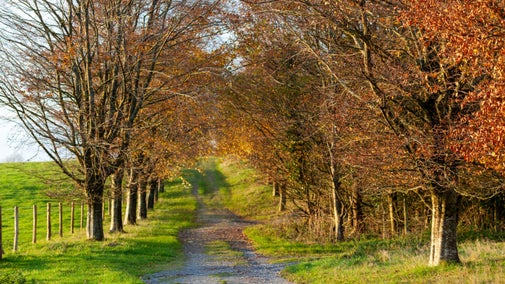
Discover more at Buckland Abbey
Find out when Buckland Abbey is open, how to get here, the things to see and do and more.

As you wander around Buckland Abbey, you'll discover fascinating tales spanning eight centuries. It’s been home to Cistercian monks, and seafarers who changed the shape of the house and the fate of the country. The Abbey is part museum, part house, and filled with treasures. Among the highlights are the medieval Great Barn, which has remained virtually unchanged since it was built centuries ago, and a Rembrandt self portrait.
Please note that the Abbey is closed from 4-29 November inclusive as the Christmas displays take shape. From 30 November - 31 December, the house is open daily except for Christmas Day and Boxing Day.
The house today still holds evidence of the original medieval complex, with hidden staircases, archways and original plaster work to discover.
The medieval abbey was pulled apart after the Dissolution of the monasteries and bought by the Grenville family. It was eventually inherited by Sir Richard Grenville, who converted it into a Tudor mansion home and carried out major renovations, creating the house seen today.
Evidence of Grenville’s conversions can be seen when approaching the Buckland Abbey; markings on the wall show where the south transept of the church once stood.
The house was later sold to the privateer Sir Francis Drake, and information on Drake’s life can be found on the top floor of the Abbey in the Lifetimes gallery.

On display in the Nave gallery, the Pym Murals commemorate Buckland Abbey’s most famous resident Sir Francis Drake and his circumnavigation of the globe and participation in the battle against the Spanish Armada fleet.
The paintings were commissioned in the 1950s by the Astor family and created by Roland Pym, an established mural painter and set designer who undertook many large-scale designs.
They vary from 1.4 to 4.8 metres wide and illustrate events from Sir Francis Drake’s life including his ship, The Golden Hind, the route he took from Plymouth and circumnavigated the globe, the capturing of the Spanish flagship, ‘The “Nuestra Senora del Rosario” and the final, victorious battles as part of the Armada.
The Great Hall at Buckland Abbey was possibly the first room created when it was converted into a house in the 16th century. This was built on what would have once been the cross-section of the church, and where the monks came to pray.
The hall today displays evidence of the flamboyance of the Elizabethan era. There are original stone flooring and plaster carvings, which demonstrate both Grenville’s and Drake's travels around the world, and Tudor wooden panelling.
Other than the Georgian additions such as the charcoal range, the kitchen today remains a traditional Tudor kitchen. In fact, it's still sometimes used by volunteers for cooking demonstrations.
The chapel at Buckland Abbey is particularly special, as it was discovered by the last Lady Drake who lived here in 1917.
During her repair work, the site of the high alter of the monks was uncovered, and today it’s possible to look in and see this focal point of the Cistercian worshippers.

In 1938, some 400 years after the Dissolution of the monasteries, the house was destroyed once again after a fire broke out on the middle floor. While Buckland’s original house layout was destroyed, the bottom floor was left intact.
Years later, Plymouth City Council and the National Trust joined to repair the property. The aim was to convert Buckland Abbey into a museum to showcase the life of Sir Francis Drake and the Abbey’s naval history.
The Abbey today still houses some of the special treasures that are on loan from the Plymouth City Museum.

The Great Barn was used by the Medieval monks to sort and winnow corn. Today it houses the cider press, which acts as a reminder of the 27 acres of orchards and farmland that once stretched down to the river.
The Nave Gallery, the kitchen and the Great Hall can all be accessed on the level. The chapel can be viewed from the corridor but there are deep steps into the room itself. All of the other rooms within the Abbey are accessed via staircases.
There is level access into the Great Barn.
For more information, please see the Access Statement on the visitor information page or call 01822 853607.

Find out when Buckland Abbey is open, how to get here, the things to see and do and more.

Discover Buckland's ancient woodland on one of three colour coded walking routes. With abundant wildlife and far reaching views, it's a peaceful and fascinating place to enjoy a stroll.

Discover a wealth of history at Buckland Abbey, from its time as a medieval farming monastery to the famous Tudor explorers who called it home.

Take a break at the Ox Yard Café, which serves tea, coffee, light lunches and sweet treats, before finding a special gift or souvenir in the National Trust shop, art galleries and second-hand bookshop.

Buckland Abbey is a one pawprint rated place. There are plenty of dog-friendly walks through the woodland and countryside to explore and dogs are welcome to relax in the Ox Yard Café.

From beautiful blooms to bountiful harvests, the gardens at Buckland Abbey are full of colour and seasonal interest. Soak up the history of this special place as you admire the planting, or simply enjoy the peace and tranquillity as you sit a while on one of the benches.